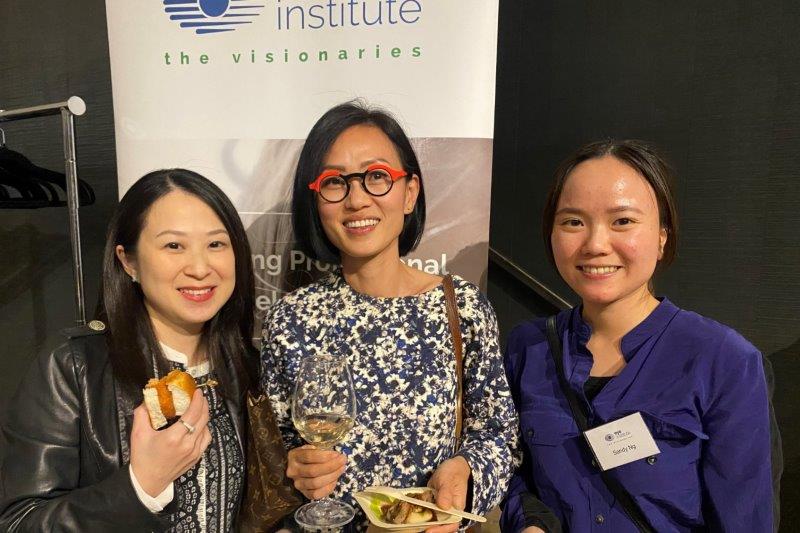Full house for EI seminar
Eye Institute’s first Auckland optometry evening seminar for 2021 attracted more than 170 eyecare professionals to the Orakei Bay conference centre in early May, and they clearly enjoyed the opportunity to catch up in person while picking up some valuable CPD points.
After mingling over some delicious finger food, Dr Shanu Subbiah welcomed everyone and congratulated Eye Institute’s own Professor Helen Danesh-Meyer for being named as one of the world’s top 100 women in ophthalmology in The Ophthalmologist’s first-ever female power list. He also proudly announced Eye Institute had received its first Rainbow Tick for diversity and inclusion, the first ophthalmology surgery in New Zealand to do so.
Auckland-based neurologist Dr Kiri Brickell and Prof Danesh-Meyer tag-teamed the first session, focusing on headaches and optic nerve red flags. Dr Brickell said she relies on a trusted set of pain questions to diagnose her patients (onset, location, character, frequency, duration, relieving or exacerbating features – triggers and medications, including frequency of use, associated symptoms and change over time). Red flags are typically a sudden onset or a change in the character of the headache, she said, adding that one condition “you can’t afford to get wrong” is temporal arteritis. This blood vessel inflammation is often associated with headaches, jaw pain, vision loss, fever and fatigue and can lead to permanent vision loss if left untreated. Diagnosis usually requires biopsy of the temporal artery and it needs prompt treatment with steroids.
Prof Danesh-Meyer delivered a fast-paced talk on disc swelling. First, quizzing the audience on how to distinguish between true disc swelling (characterised by hyperaemia, microvascular abnormalities, blurring of the disc margin, haemorrhage and cotton wool spots) versus pseudo disc swelling (absent cup, small disc, venous pulsation, anomalous branching, irregular margin and presence of drusen) before moving on to the ‘good’ – pseudopapilloedema.
Pseudopapilloedema patients present with normal visual acuity (VA), colour vision and visual field (VF) and ‘normal’ optical coherence tomography (OCT), except for myopes, who present with an unusual OCT and thin ganglion cell layers. The ‘bad’ optic nerve drusen is often difficult to diagnose and thus creates anxiety for both patient and clinician, she said. A non-urgent referral is recommended if VF defects are significant or if there’s anything unusual about the case.
Papilloedema is a medical emergency as it can be associated with significant intracranial disease and cause blindness, said Prof Danesh-Meyer. Symptoms typically include headache, pulsatile tinnitus, diplopia and transient visual obscuration. Recommended investigative measures include VA, colour vision, VF and disc assessment. She also discussed idiopathic intracranial hypertension (IIH), an increasingly common cause for headache largely due to the growing obesity epidemic in New Zealand. IIH requires ongoing monitoring and while there are treatments available to preserve vision and relieve headaches (acetazolamide and topiramate), the only defensive cure is weight loss, she said. “Achieve a 10-15% weight loss and the symptoms go away.”
Next up, Dr Kaliopy Matheos, Eye Institute’s newest surgeon, shared some recent cases illustrating why normal tension glaucoma (NTG) isn’t always straightforward to diagnose when patients present with glaucoma-like clinical features. Evaluations should always include thorough history-taking, colour vision, relative afferent pupillary defect (RAPD) and gonioscopy, she said.
Professor Charles McGhee discussed iris lesions. While pigmented iris lesions can be difficult to diagnose, thankfully, the majority are benign freckles and naevi. For smaller lesions, an annual photographic observation is appropriate, while higher risk lesions need more careful consideration, he said. They can be diagnosed using the ‘ABCDEF’ classification – Age ≤40 years; Blood in the anterior chamber; Clock-hour inferior; Diffuse configuration; Ectropion and Feathery margins. Iris melanoma, a rare intraocular malignancy, represents 4% of uveal melanomas (90% choroidal melanoma and 6% cilliary body melanoma). While no major study has been undertaken in New Zealand to date, it typically presents in individuals of European descent with blue/green irises, with an incidence of one per million per year. The ABCDEF classification is useful to help identify factors predictive of a potential iris naevi transforming into iris melanoma, said Prof McGhee, ending his talk with a prudent reminder that ultimately 20-30% of larger lesions are melanoma and require attention.
Dr Narme Deva and Auckland-based interventional cardiologist Dr Peter Barr rounded off the evening with a talk on hypertension, cardiovascular disease and retinal vascular disease. Dr Barr highlighted that while a one-off blood pressure measurement isn’t diagnostic, it can help prompt future questions. Checking blood pressure should be part of an optometrist’s routine assessment, referring patients with hypertension or an irregular pulse to their GP, he said.
Dr Deva discussed causes, symptoms, diagnosis and management of retinal artery occlusion (RAO) and retinal vein occlusion (RVO). RAO is an ocular stroke and presents as painless, acute vision loss in one eye. It affects approximately one in 100,000 – predominantly males aged 60-65 years. While there is no proven RAO ocular treatment to date, a suspected case must be referred immediately as it is associated with a higher risk of stroke and cardiac events. RVO can cause sudden blindness and is classified as ischaemic or non-ischaemic (most common). Main risk factors are age, hypertension and arteriolar narrowing, diabetes and open-angle glaucoma. Classic signs are retinal venous dilation or tortuosity, retinal haemorrhages, cotton wool patches caused by infarcts in the nerve fibre layer and macula oedema. RVO treatment options include observation, laser, steroids and anti-VEGF therapy, the latter having revolutionised RVO management, resulting in improved visual outcomes (SCORE 2 and RETAIN studies). Summing up, Dr Deva said patients presenting with these signs who are young, have associated systemic conditions or have experienced multiple episodes need to be referred promptly, while an urgent referral is required in cases where RVO is suspected ischaemic or there is evidence of neovascularisation or neovascular glaucoma.























